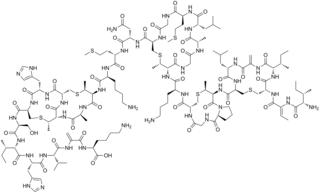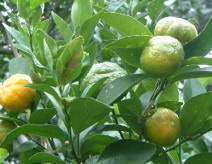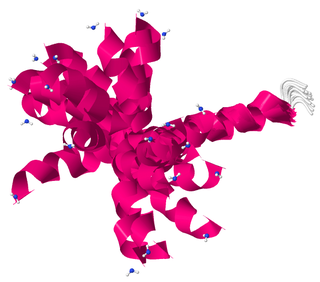Related Research Articles

Kombucha is a fermented, lightly effervescent, sweetened black or green tea drink commonly consumed for its supposed health benefits. Sometimes the beverage is called kombucha tea to distinguish it from the culture of bacteria and yeast. Juice, spices, fruit or other flavorings are often added to enhance the taste of the beverage.

Methylisothiazolinone, MIT, or MI,, is a powerful synthetic biocide and preservative within the group of isothiazolinones, which is used in numerous personal care products and a wide range of industrial applications.

Nisin is a polycyclic antibacterial peptide produced by the bacterium Lactococcus lactis that is used as a food preservative. It has 34 amino acid residues, including the uncommon amino acids lanthionine (Lan), methyllanthionine (MeLan), didehydroalanine (Dha), and didehydroaminobutyric acid (Dhb). These unusual amino acids are introduced by posttranslational modification of the precursor peptide. In these reactions a ribosomally synthesized 57-mer is converted to the final peptide. The unsaturated amino acids originate from serine and threonine, and the enzyme-catalysed addition of cysteine residues to the didehydro amino acids result in the multiple (5) thioether bridges.
Lantibiotics are a class of polycyclic peptide antibiotics that contain the characteristic thioether amino acids lanthionine or methyllanthionine, as well as the unsaturated amino acids dehydroalanine, and 2-aminoisobutyric acid. They belong to ribosomally synthesized and post-translationally modified peptides.

Citrus depressa, in English sometimes called shiikuwasha, shequasar, Taiwan tangerine, Okinawa lime, flat lemon, hirami lemon, or thin-skinned flat lemon, is a small, green citrus fruit rich in flavonoids and native to East Asia.

Antimicrobial peptides (AMPs), also called host defense peptides (HDPs) are part of the innate immune response found among all classes of life. Fundamental differences exist between prokaryotic and eukaryotic cells that may represent targets for antimicrobial peptides. These peptides are potent, broad spectrum antibiotics which demonstrate potential as novel therapeutic agents. Antimicrobial peptides have been demonstrated to kill Gram negative and Gram positive bacteria, enveloped viruses, fungi and even transformed or cancerous cells. Unlike the majority of conventional antibiotics it appears that antimicrobial peptides frequently destabilize biological membranes, can form transmembrane channels, and may also have the ability to enhance immunity by functioning as immunomodulators.

Azelaic acid is an organic compound with the formula HOOC(CH2)7COOH. This saturated dicarboxylic acid exists as a white powder. It is found in wheat, rye, and barley. It is a precursor to diverse industrial products including polymers and plasticizers, as well as being a component of a number of hair and skin conditioners.

Orange oil is an essential oil produced by cells within the rind of an orange fruit. In contrast to most essential oils, it is extracted as a by-product of orange juice production by centrifugation, producing a cold-pressed oil. It is composed of mostly d-limonene, and is often used in place of pure d-limonene. D-limonene can be extracted from the oil by distillation.

Eccrine glands are the major sweat glands of the human body, found in virtually all skin, with the highest density in palm and soles, then on the head, but much less on the torso and the extremities. In other mammals, they are relatively sparse, being found mainly on hairless areas such as foot pads. They reach their peak of development in humans, where they may number 200–400/cm² of skin surface. They produce a clear, odorless substance, sweat, consisting primarily of water.
A vacuum fryer is a deep-frying device housed inside a vacuum chamber.

Granulysin, also known as GNLY, is a protein which in humans is encoded by the GNLY gene. It is also known as NK-lysin (NKL) after NK cells; the cattle ortholog is sometimes referred to as Bo-lysin.

Isomaltose is a disaccharide similar to maltose, but with a α-(1-6)-linkage instead of the α-(1-4)-linkage. Both of the sugars are glucose, which is a pyranose sugar. Isomaltose is a reducing sugar. Isomaltose is produced when high maltose syrup is treated with the enzyme transglucosidase (TG) and is one of the major components in the mixture isomaltooligosaccharide.

Cecropins are antimicrobial peptides. They were first isolated from the hemolymph of Hyalophora cecropia, whence the term cecropin was derived. Cecropins lyse bacterial cell membranes; they also inhibit proline uptake and cause leaky membranes.
The respiratory tract antimicrobial defense system is a layered defense mechanism which relies on components of both the innate and adaptive immune systems to protect the lungs and the rest of the respiratory tract against inhaled microorganisms.

The grape reaction product is a phenolic compound explaining the disappearance of caftaric acid from grape must during processing. It is also found in aged red wines. Its enzymatic production by polyphenol oxidase is important in limiting the browning of musts, especially in white wine production. The product can be recreated in model solutions.
Weissella hellenica is a species of Gram-positive bacteria, placed within the family of Leuconostocaceae. It is frequently isolated from fermented sausage and flounder intestine, as well as Korean fermented pickle Kimchi and barrels used to make Japanese pickles. Some strains have been observed to be probiotic while some have not. Some strains produce bacteriocins named weissellicins which show antimicrobial activity against other bacteria.

Zingibain, zingipain, or ginger protease is a cysteine protease enzyme found in ginger rhizomes. It catalyses the preferential cleavage of peptides with a proline residue at the P2 position. It has two distinct forms, ginger protease I (GP-I) and ginger protease II (GP-II).
Hedonic hunger or hedonic hyperphagia is "the drive to eat to obtain pleasure in the absence of an energy deficit." Particular foods may have a high "hedonic rating" or individuals may have increased susceptibility to environmental food cues. Weight loss programs may aim to control or to compensate for hedonic hunger. Therapeutic interventions may influence hedonic eating behavior.

Zdenka Samish was a Czech-Israeli food technology researcher. One of the first agricultural researchers in pre-state Israel, she studied methods for industrial processing of fruits and vegetables, canning, and food infestation. Her research was published in numerous peer-reviewed journals. She was director of the Department of Food Technology at the Agricultural Research Station in Rehovot from the early 1950s to 1969.
Esculentin-2CHa is an antimicrobial peptide located outside the epithelial cell's membrane of the skin of many species of amphibians, such as Rana chiricahuensis. This peptide has recently become more important due to its defense response function and its possible application in the treatment of various human pathologies, that range from type 2 diabetes to bacterial and fungi infections. Esculentin-2CHa is a peptide that belongs to the Esculentin-2 family, which is known for its broad-spectrum of antimicrobial activity and its low cytotoxicity to human erythrocytes. However, not much is known about its structures and their relation to the functions these peptides carry out.
References
- ↑ Burrowes, O. J.; Hadjicharalambous, C.; Diamond, G.; Lee, Tung-Ching (2004-04-01). "Evaluation of Antimicrobial Spectrum and Cytotoxic Activity of Pleurocidin for Food Applications". Journal of Food Science. 69 (3): FMS66–FMS71. doi:10.1111/j.1365-2621.2004.tb13373.x. ISSN 1750-3841.
- ↑ Cole AM, Weis P, Diamond G (May 1997). "Isolation and characterization of pleurocidin, an antimicrobial peptide in the skin secretions of winter flounder". J. Biol. Chem. 272 (18): 12008–13. doi: 10.1074/jbc.272.18.12008 . PMID 9115266.
- ↑ Burrowes, O. J.; Hadjicharalambous, C.; Diamond, G.; Lee, Tung-Ching (2004-04-01). "Evaluation of Antimicrobial Spectrum and Cytotoxic Activity of Pleurocidin for Food Applications". Journal of Food Science. 69 (3): FMS66–FMS71. doi:10.1111/j.1365-2621.2004.tb13373.x. ISSN 1750-3841.